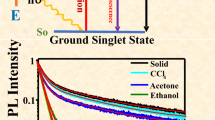Abstract
2′-Ethylhexyl-4-Methoxycinnamate (EHMC), also designated as octinoxate, is an oily UV-absorber used in sunscreens for the protection of human skin against solar UV-radiation and represents one of the most employed UVB absorbers for that application. In water-in-oil emulsions EHMC was adjusted at a constant overall concentration, while changing the EHMC concentration in the oil droplets by adding a non-absorbing oil. In that way the EHMC concentration could be varied at constant optical thickness. Here we show that the kinetics of the photoreaction follows a second-order rate law, in line with the UV-induced [2 + 2]-cycloaddition reaction mechanism known for this UV absorber. The second-order rate constant decreased with higher overall EHMC concentration. This can be explained by the fact, that at higher overall concentration of the UV absorber not every EHMC molecule will absorb a photon due to the increased optical density, so that on average less photons are absorbed per molecule. On the other hand, the rate constant increases with decreasing polarity of the surrounding oil. Since the molar fraction of the trans-isomer of EHMC is augmented at lower polarity, more photons are absorbed in this case, as the strength of the absorption band of the trans-isomer is significantly higher than that of the cis-isomer. In conclusion, our experiments show that a high polarity of the oil phase and a high concentration of EHMC are advantageous for the photostability of this compound.
Similar content being viewed by others
References
B. Herzog, Photoprotection of Human Skin, Photochemistry, 2012, 40, 245–273.
N. Shaath, The Chemistry of Ultraviolet Filters, in, Sunscreens – Regulation and Commercial Development, ed. N. Shaath, Taylor & Francis, Boca Raton, 3rd edn, 2005.
S. Matsumoto, R. Kumasaka, M. Yagi and A. Kikuchi, Triplet-triplet energy transfer between UV absorbers in solutins at room temperature, J. Photochem. Photobiol., A, 2017, 346, 396–400.
P. Morliere, O. Avice, T. Sa E Melo, L. Dubertret, M. Giraud and R. Santus, A study of the photochemical properties of some cinnamate susnscreens by steady state and laser flash photolysis, Photochem. Photobiol., 1982, 36, 395–399.
S. Pattanaargson, T. Munhapol, P. Hirunsupachot and P. Luanfthongaram, Photoisomerization of octyl methoxycinnamate, J. Photochem. Photobiol., A, 2004, 161, 269–274.
H. Stobbe, Zur Photochemie einiger Zimtsäure-Derivate, Ber. Dtsch. Chem. Ges., 1925, 58, 2859–2863.
J. K. Broadbent, B. S. Martincigh, M. W. Raynor, M. F. Salter, R. M. Moulder, P. Sjöberg and K. E. Markides, Capillary supercritical fluid chromatography combined with atmospheric pressure chemical ionisation mass spectrometry for the investigation of photoproduct formation in the sunscreen absorber 2-ethylhexyl-p-methoxycinnamate, J. Chromatogr. A, 1996, 732, 101–110.
A. Schrader, J. Jakupocic and W. Baltes, Photochemical studies on, trans-3-methylbutyl 4-methoxycinnamate, J. Soc. Cosmet. Chem., 1994, 45, 43–52.
H. V. Stein, C. J. Berg, J. N. Maung, L. O. O’Connor, A. E. Pagano, L. A. MacManus-Spencer and M. G. Paulick, Photolysis and cellular toxicities of the organic ultraviolet filter chemical octyl methoxycinnamate and its photoproducts, Environ. Sci.: Processes Impacts, 2017, 19, 851–860.
D. Dondi, A. Albini and N. Serpone, Interactions between different solar UVB/UVA filters contained in commercial suncreams and consequent loss of UV protection, Photochem. Photobiol. Sci., 2006, 5, 835–843.
B. Herzog, M. Wehrle and K. Quass, Photostability of UV absorber systems in sunscreens, Photochem. Photobiol., 2009, 85, 869–878.
J. Kockler, M. Oelgemöller, S. Robertson and B. D. Glass, Photostability of sunscreens, J. Photochem. Photobiol., C, 2012, 13, 91–110.
M. E. Carlotti, S. Sapino, D. Vione, C. Minero, M. Trotta and M. Gallarate, Photostability of octyl-p-methoxy cinnamate in o/w emulsions and in SLNs vehicle in the emulsion, J. Dispersion Sci. Technol., 2007, 28, 1034–1043.
J. K. Yoon and D. J. Burgess, Comparison of dynamic and static interfacial tension at aqueous/perfluorocarbon interfaces, J. Colloid Interface Sci., 1992, 151, 402–409.
P. W. Atkins, Physical Chemistry, Oxford University Press, 3rd edn, 1986, Ch. 28.2, pp. 689–698.
B. Herzog and U. Osterwalder, Simulation of sunscreen performance, Pure Appl. Chem., 2015, 87, 937–951.
Anonymous, BASF sunscreen simulator. BASF Personal Care and Nutrition GmbH, Monheim, Germany, 2018. Available at http://www.sunscreensimulator.basf.com.
Author information
Authors and Affiliations
Corresponding author
Rights and permissions
About this article
Cite this article
Herzog, B., Amorós-Galicia, L., Sohn, M. et al. Analysis of photokinetics of 2’-ethylhexyl-4-methoxycinnamate in sunscreens. Photochem Photobiol Sci 18, 1773–1781 (2019). https://doi.org/10.1039/c9pp00084d
Received:
Accepted:
Published:
Issue Date:
DOI: https://doi.org/10.1039/c9pp00084d



